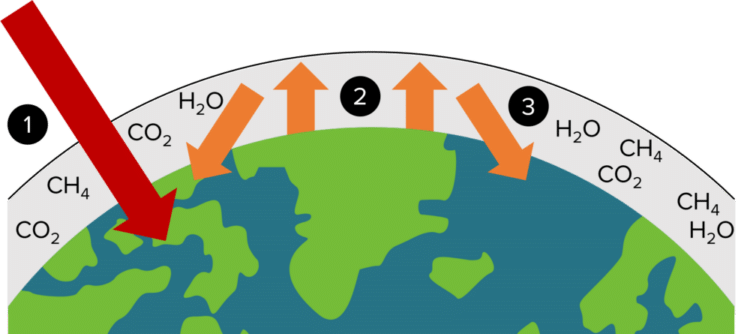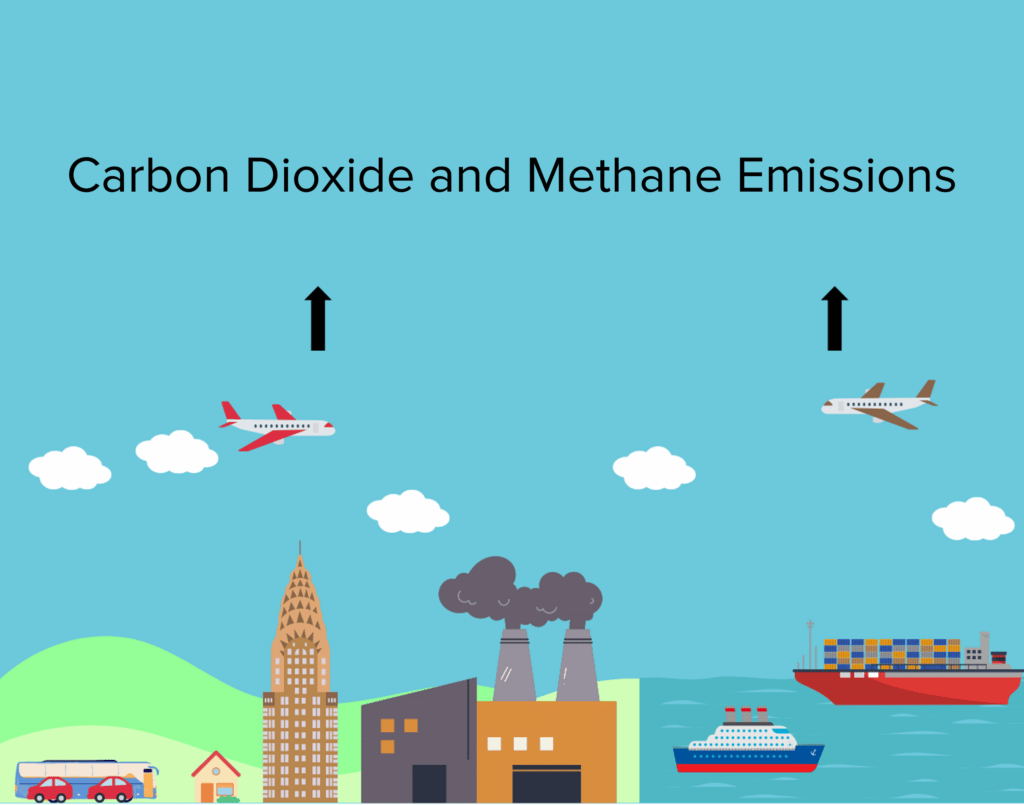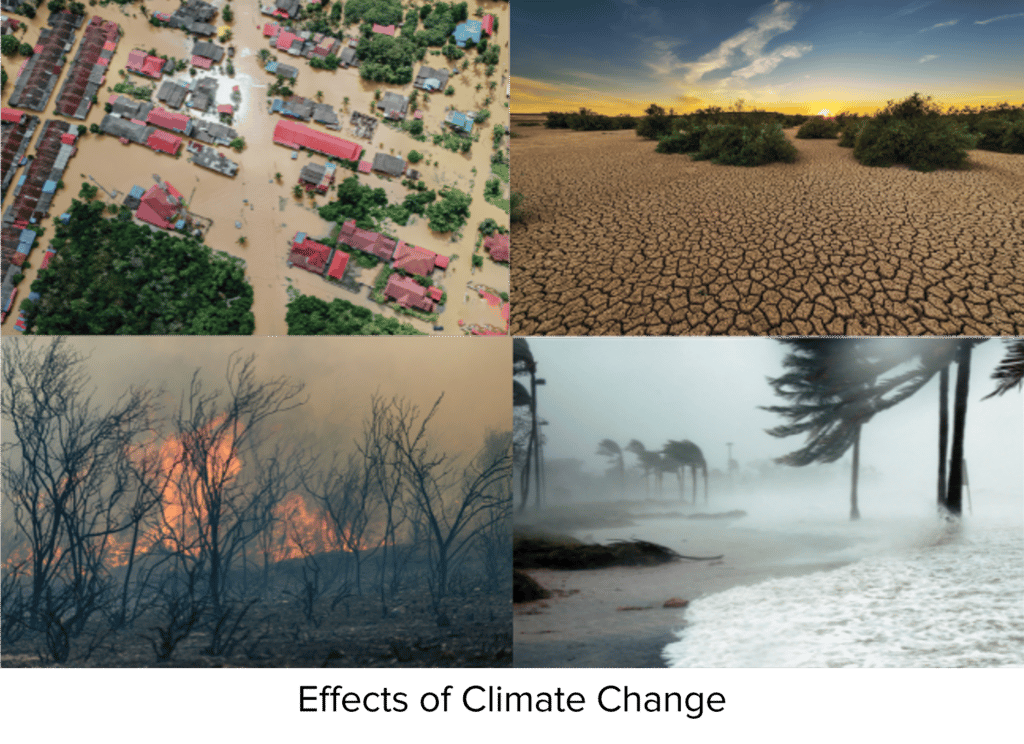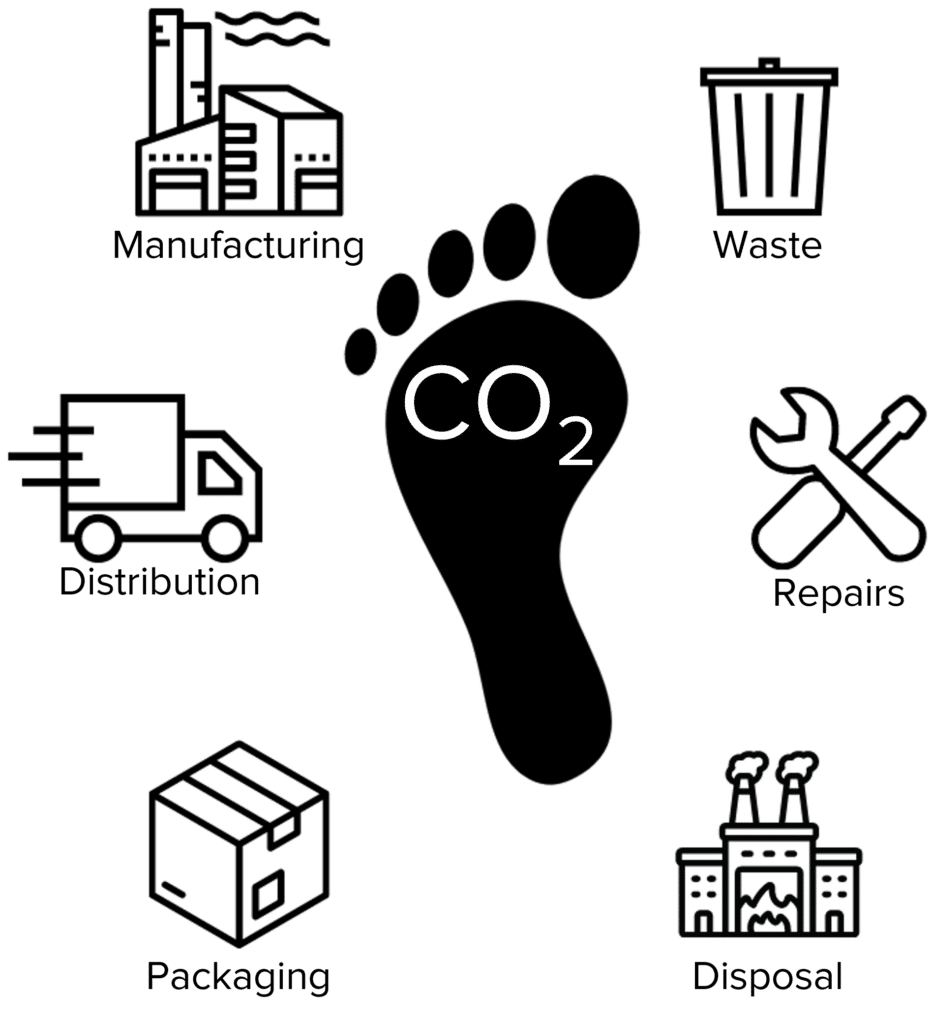Greenhouse Gasses
Greenhouse Gasses Revision
Greenhouse Gasses
Greenhouses gasses have been instrumental in the development of life on Earth. They have kept temperatures high enough on the planet’s surface to allow life to thrive. Modern human activity is disrupting the stability of the climate by strengthening the greenhouse effect. Scientists have shown that global temperatures are rising as a result of human activity. To combat this disruption, people and societies should try to reduce their carbon footprint.
The Greenhouse Effect
The greenhouse effect is vitally important in maintaining the warm temperatures of the Earth’s surface, allowing life to thrive. Thanks to the greenhouse effect, the average temperature on Earth is around 15\degree \text{C}, without the greenhouse effect, the surface temperature of the Earth would be far lower. For example Mercury has no greenhouse effect. As a result, nights on the surface can drop as low as -180\degree \text{C}.
The greenhouse effect is the result of gasses in the atmosphere that are able to trap heat from the Sun and prevent heat loss from Earth’s surface. The three most important greenhouse gasses are carbon dioxide, water vapour, and methane.
The greenhouse effect essentially works in three stages.
- Shortwave solar radiation travels from the Sun to the Earth. This radiation passes through the atmosphere and is absorbed by the planet’s surface.
- The warm surface then radiates longwave thermal radiation into the atmosphere. This longwave radiation is absorbed by the greenhouses gasses in the atmosphere, preventing it from escaping into space.
- These greenhouses gasses re-radiate the longwave radiation back towards the Earth. This process traps heat from the sun at the surface of the Earth, rising the average surface temperature.

Though the greenhouse effect has been incredibly important in the development of life on Earth, human activity is now turning it into a serious threat.
Human Activity and the Greenhouse Effect
Scientist now know that human activity is having a profound effect on the Earth’s greenhouse.

Since the advent of the industrial revolution, emissions of carbon dioxide have massively increased. The fossil fuels burned to feed modern industry, transport, and urban life have all contributed to an increase in the amount of greenhouse gases present in the Earth’s atmosphere. This increase has strengthened the greenhouse effect, leading to a a rise in global temperatures.
Examples of human activities that have contributed to this increase are motor transport (i.e. cars, busses, and lorries), industrial manufacturing, air travel, and shipping.
Each of these factors have contributed increasing carbon emissions in different amounts, but all are features of modern human society. This is something of an ethical conundrum.
There are natural processes that will counteract human driven emissions, such as the removal \text{CO}_2 from the air by photosynthesis, however industrial process like deforestation and farming are reducing these processes.
The biggest reduction comes from land clearance for large scale agriculture. Deforestation around the world has been driven by the need grow large amounts of crops such as soy beans that can be used as feedstock for cattle. This removes large numbers of trees that might have otherwise have removed carbon dioxide from the atmosphere for photosynthesis. With some estimates putting the loss of the worlds forest at 50\% in the last 70 years, this has contributed to a massive decline in the amount of carbon that is taken out of the air.
Additionally, one of the most common methods used to clear land for agricultural purposes is through controlled burning. This effectively means starting deliberate forest fires to remove the pre-existing plant life. By burning plant matter, a natural store of \text{CO}_2, a large amount of greenhouse gases are released back in to the air.
Industrial farming also leads to an increase in methane emissions. Cattle farming contributes massively to the production of methane through animal waste. Rice farming also generates large amounts of methane through the decomposition of organic matter in flooded rice paddies.
Climate Change
The single most important result of rising emissions has been the onset of global climate change. Climate change refers to the collection of changes in the temperature, weather, and atmosphere of the planet that are results from an increasingly strong greenhouse effect. Examples of these changes are:

- Rising average global temperatures.
- Loss of ice in the polar regions due to warming.
- More extreme variations in seasonal temperatures.
- More extreme weather.
- More frequent weather based natural disasters, such as hurricanes, flooding, forest fires, and droughts.
- Increasing desertification.
All of these effects can, and frequently do, have incredibly destructive effects. Each of them produce a number of secondary effects, including damage to energy infrastructure, displacement of people, and the spread of more infectious diseases. Climate change is also leading to the loss of global habitats, meaning the possible extinction of many species of wild animal such as polar bears, tigers, walruses, and koalas.
Though the climate naturally changes over time, scientists have shown the climate change currently occurring is driven by human caused changes to the greenhouse effect. This has been firmly established though thousands of peer reviewed studies and is backed up by a wealth of data and evidence.
Despite this fact, there are some voices who continue to claim that climate change is either a natural process unaffected by human action or, in the more extreme cases, that it is not happening at all. However, the arguments put forth against man-made climate change are often lacking in evidence, misinterpret the data (often deliberately), and are heavily biased.
For example, the argument that modern day climate change is simply a natural phenomenon often point to periods of warming that have occurred in the past. However, this argument ignores the speed and extent of modern climate change. Warming in the past has often taken place over the span of thousands of years.
For example, after the last ice age, global temperatures rose by about 3\degree \text{C} over a period of around 5,000 years, a rate of around +0.0006\degree \text{C} a year. In the last century alone global temperatures have risen by 0.7\degree \text{C}, just over 10\times faster than previous warming events.
Carbon Footprints

The carbon footprint of an object is an idea used to help us understand how a product or processes generates greenhouse gas emissions. The carbon footprint of a product is the sum of all the greenhouse gasses that are emitted – directly or indirectly – by a product across it’s whole life.
Greenhouse gasses may be generated at multiple stages of a products life. Greenhouse gasses will be released during the manufacture of products, during their distribution to other places, and by the production of packaging to contain them for sale. For some products, such as motor vehicles, using them will generate greenhouse gas emissions.
Some products may need repairs thought-out their life and this can also be a source of greenhouse gasses.
Finally, the disposal of products that have come to the end of their useable lives will again generate green house gasses.
Individual people will also have a carbon footprint as a result of their day to day activities. It is possible for us to try and work to reduce our carbon footprints in a number of ways.
Buying only products that we need, and avoiding too much unnecessary consumption will cut down out carbon foot prints by reducing manufacturing and disposal. Only running electrical goods that are being used is another way to reduce your own carbon foot print. Other small changes include using more public transport when traveling and walking where possible, turning out lights in empty rooms, only boiling as much water as is needed for a cup of tea. Though these actions may be small, they all contribute to reducing your, and therefore societies, carbon footprint.
Personal changes can only do so much however. The biggest carbon foot prints come not from individuals but from large corporations and governments. Without changing the way these organizations operate it will be difficult to reduce the overall carbon footprint of society. Convincing these organizations, particularly large corporations, to change their behaviours is not easy. However, people can try to influence these organisations through public pressure, e.g. writing letters to MPs to tell them to change, publicising information about the changing climate, encouraging greener policies in your school or work place, and avoiding using services or buying products from companies that continue to contribute to emissions.
Greenhouse Gasses Example Questions
Question 1: Why is the greenhouse effect important?
[2 marks]
It keeps temperatures on Earth high enough for life to exist.
Question 2: State two human activities that contribute to climate change.
[2 marks]
Any two from:
- Motor transport.
- Shipping.
- Manufacturing.
- Air travel.
- Heating.
- Electricity generation.
- Industrial Farming.
Question 3: State two impacts of climate change.
[2 marks]
Any two from:
- Rising average global temperatures.
- Loss of ice in the polar regions due to warming.
- More extreme variations in seasonal temperatures.
- More extreme weather.
- More frequent weather based natural disasters, such as hurricanes, flooding, forest fires, and droughts.
- Increasing desertification.
- Increased spread of disease.
- Habitat loss.
- Extinction of animal species.
- Displacement of people.





